Amphibians like a baby axolotl are a neat way to keep something other than fish in an aquarium.
They eat less often, are less active, and require less maintenance.
Axolotls are also quite long lived and one of the stranger looking pets in the hobby.
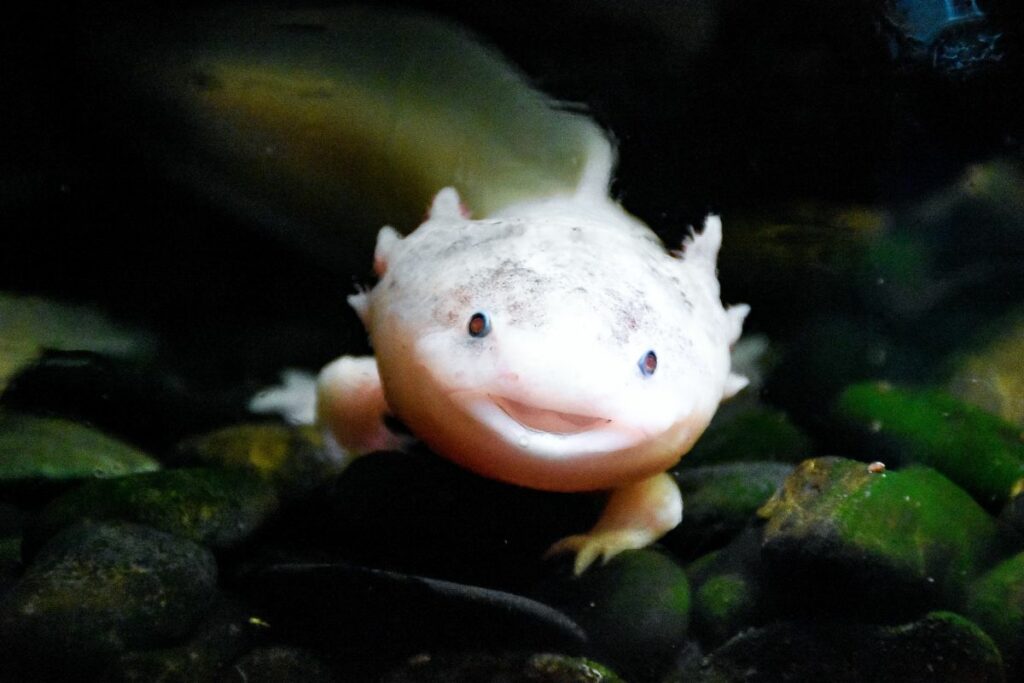
So how to take care of an axolotl? We’ll be discussing this topic in great detail in this detailed axolotl care guide.
What is a Baby Axolotl?
The axolotl is one of the most unusual amphibians in the world and an interesting pet. They are related to the Tiger Salamander (Ambystoma tigrinum), which lives in most of North America.
What makes the axolotl unique is that it is stuck in its larval stage. A young Tiger Salamander looks very similar to an adult axolotl. But when grown up they lose their gills and live on land.
| Category | Axolotl | Salamander |
|---|---|---|
| Appearance | Large head, external gills, flat body with stubby limbs | Sleek body with smooth skin, short limbs |
| Habitat | Native to Xochimilco and Chalco in central Mexico | Found in various habitats worldwide, including forests, lakes, and rivers |
| Life Cycle | Capable of both sexual and asexual reproduction, with gills throughout their entire life | Typically undergo metamorphosis from aquatic larva with gills to a terrestrial adult with lungs |
| Diet | Carnivorous, mainly feeds on small fish, insects, and crustaceans | Carnivorous, mainly feeds on insects, worms, and small vertebrates |
| Behavior | Relatively inactive, prefer to stay in one place | More active, can move quickly on land and in water |
| Size | Can grow up to 30 cm (12 inches) in length | Can vary in size depending on species, ranging from a few centimeters to over a meter |
| Regeneration | Can regenerate lost limbs and some organs | Some species can regenerate lost limbs, but not to the same extent as axolotls |
| Conservation Status | Listed as critically endangered by the IUCN Red List due to habitat loss and pollution | Various conservation statuses depending on the species, some are threatened while others are of least concern |
Axolotls are known as neotenic salamanders. Neoteny is a trait where an animal never fully loses its juvenile characteristics. By holding onto their gills and remaining in the water an axolotl is really just an adult stuck in the larval stage.
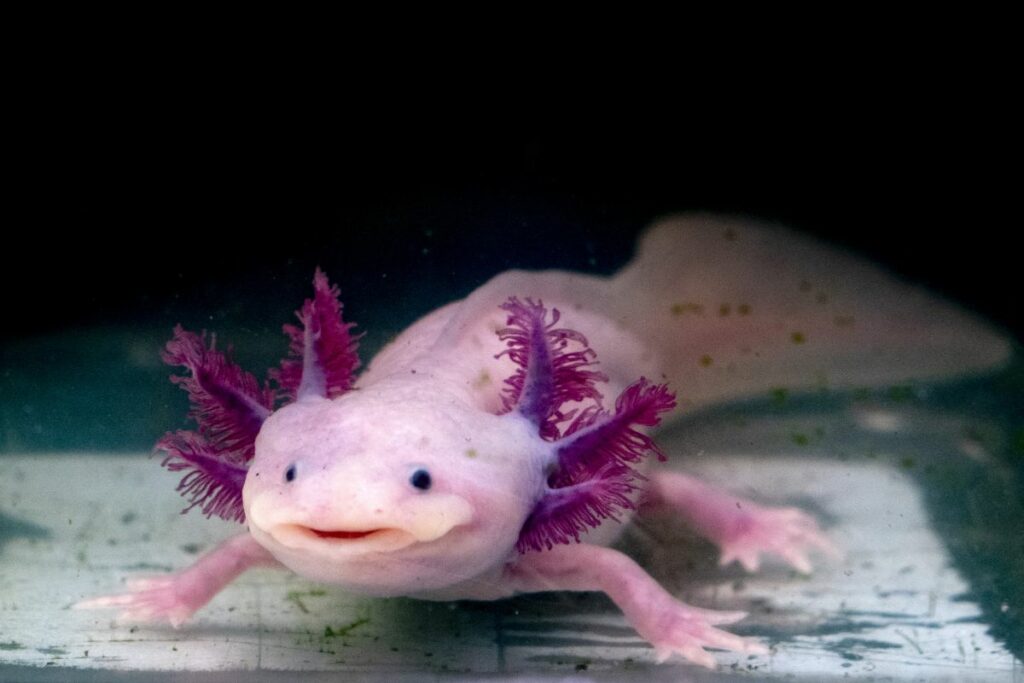
In a very real sense all axolotls are baby axolotls. The adults will reproduce and have babies but never grow up and move onto land.
The name “axolotl” is a Nahuatl (Aztec) word, pointing to its importance to for the indigenous inhabitants of Mexico City. Adult axolotls were sold as food for centuries in the area.
As Mexico City grew over the years the lakes it was built over (Lake Xochimilco, in particular) have shrunk. The wild axolotl is now critically endangered in the wild. Introduced fish like tilapia eat axolotl babies and eggs. And the lake’s water parameters are threatened by pollution from the city.
Still, the species itself is not going to go extinct. Adult axolotls breed fast so there are thousands in captivity now. Axolotl life expectancy is also very long; 20 years is not unheard of for a healthy adult.
Adult axolotls are pretty large so most aquarists start out with a baby axolotl. With their beady eyes and fluffy gills a newly hatched axolotls is hard not to adore. But how easy are they to care for?
- Common Names: Axolotl, Mexican Walking Fish
- Scientific Name: Ambystoma mexicanum
- Origin: Central Mexico (Lake Xochimilco)
- Length: Up to 12 inches
- Aquarium Size: 10 to 20 gallons
- Temperament: Predatory; Semi-Aggressive
- Ease of Care: Very Easy
How to Take Care of An Axolotl
Amphibians like a baby axolotl are quite easy to care for. Like fish they need a filter and good water quality. But neither a heater nor loads of decorations are needed. Therefore a tank is inexpensive and quick to set up.
Setting Up an Axolotl Tank
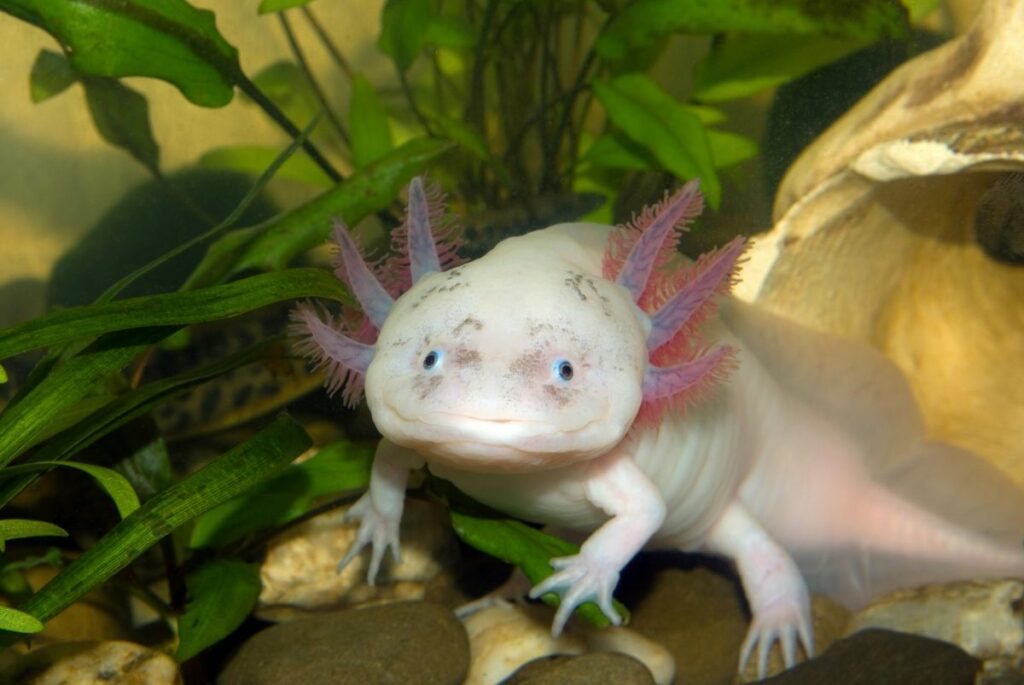
Setting up a tank for baby axolotls is a simple matter. Decorations should be quite simple because baby axolotls don’t care much about plants, rocks, or other addition. A single piece of cover is nice if your baby axolotl is feeling shy. A cave or curving chunk of driftwood is perfect.
Minimal lighting is all you need as well. Baby axolotls have poor vision but they are sensitive to bright light. Wild axolotls live in dark, muddy conditions and feel exposed if kept too well lit. Floating plants will also help dim the lighting while providing a beautiful lake environment for your baby axolotl.
Floating plants also can’t be uprooted by a clumsy baby axolotl hunting for food. Plants also absorb ammonia, nitrite, and nitrate, helping your aquarium filter keep the water clean.
Tank Size for Axolotl Babys
A cute baby axolotl does not need a lot of space. Even adult axolotls can get by with little room. These salamanders do not have fast metabolisms, nor do they move around too much.
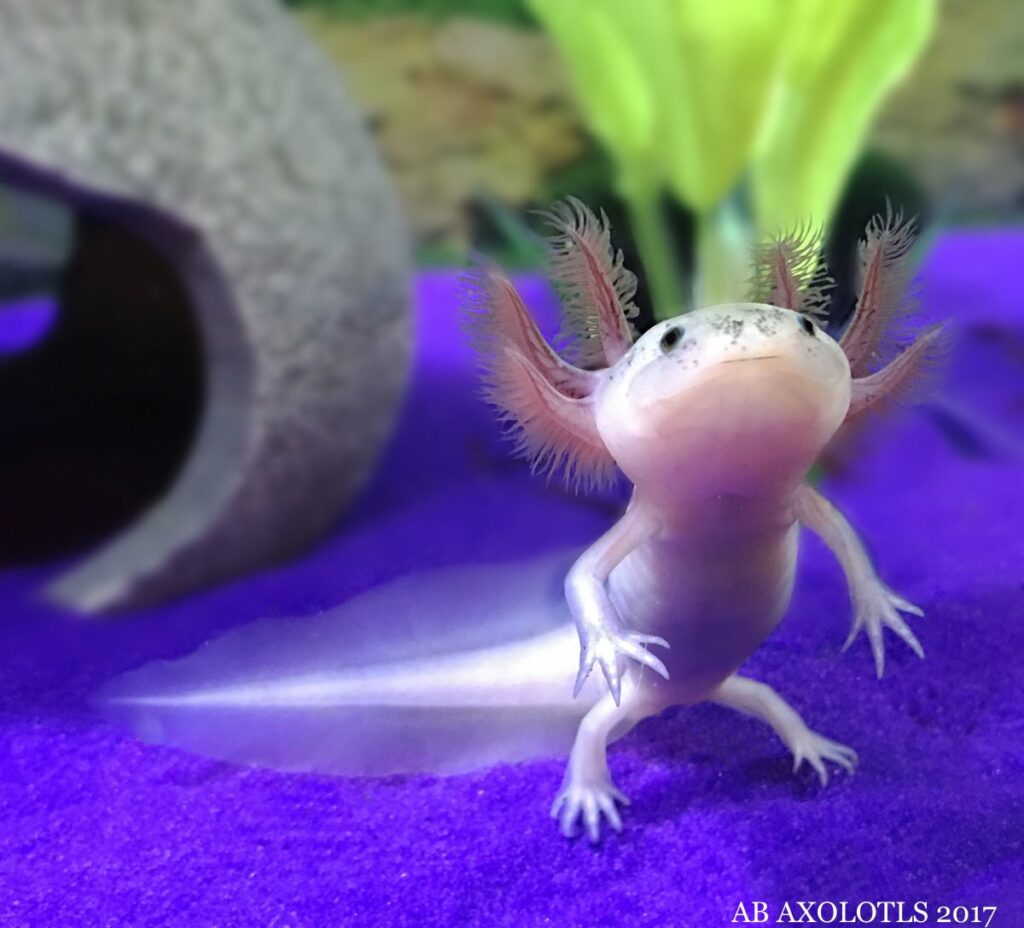
A 10 gallon freshwater aquarium is enough to last a baby axolotl its entire life. I recommend upgrading to a 20 gallon axolotl tank once your pet gets larger than 6 inches or so, however.
Adult axolotls are very messy animals. They create a lot of poop and ammonia, which will tax even the best aquarium filter. A smaller tank size will foul much faster and require frequent partial water changes.
Therefore a larger fish tank volume will help you prevent poor water quality from impacting their health.
| Category | Baby Axolotl | Adult Axolotl |
|---|---|---|
| Size | 5-7 cm (2-3 inches) | 23-30 cm (9-12 inches) |
| Appearance | Gills are external and bushy | Gills are smaller and less noticeable |
| Behavior | More active and curious | Less active and prefer to stay in one place |
| Diet | Feed mainly on live food such as brine shrimp and bloodworms | Can eat a variety of foods including pellets and frozen foods |
| Growth Rate | Rapid growth rate | Slow growth rate |
| Care | Require more frequent water changes and smaller tank size | Require larger tank size and less frequent water changes |
| Health | More vulnerable to diseases and need extra care | Tend to be hardy and more resistant to diseases |
| Lifespan | Shorter lifespan, around 5-7 years | Longer lifespan, around 10-15 years |
| Reproduction | Axolotls are capable of both sexual and asexual reproduction, with males producing sperm and females producing eggs | |
| Sperm | Axolotl sperm is unusual in that it lacks a flagellum, a tail-like structure that propels the sperm forward. Instead, it uses a unique mechanism called a “spin flagellum” to move through the water and fertilize eggs |
Baby Axolotl Water Conditions
Water parameters for a baby axolotl are not at all complicated; these salamanders are hardy and long-lived. Extremes in water hardness and pH should be avoided; a pH of 6.5-7.5 is ideal for them.
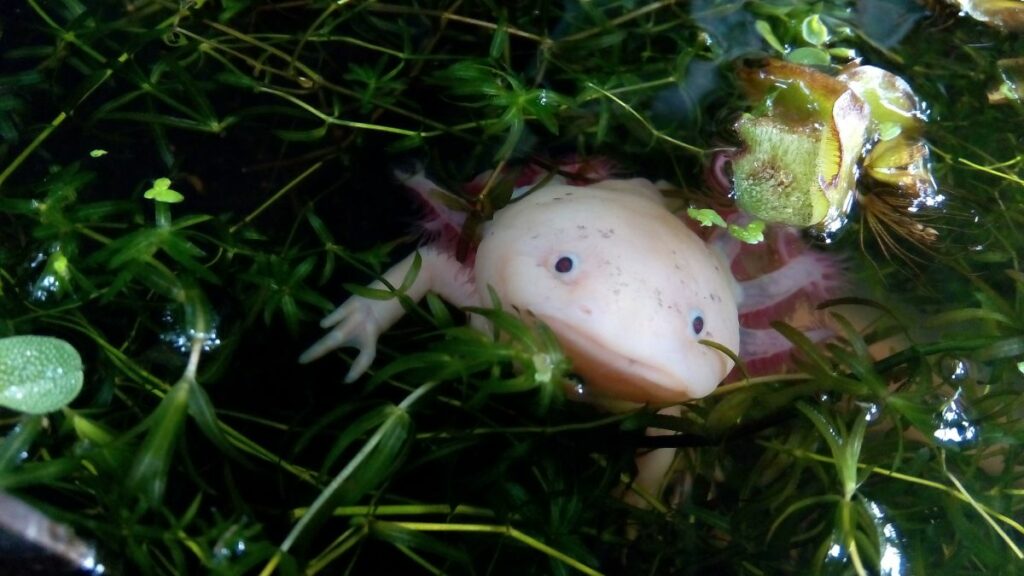
Maintaining good water quality is also important. While axolotl larvae are not too sensitive to high ammonia levels it is still toxic. So don’t skip regular water changes or filter maintenance.
Water temperature is much more important, however. Lake Xochimilco is a mountain lake and the temperature range is quite cool. Baby axolotls are most comfortable with a water temperature range of 60-68°F.
A little warmer is okay but an aquarium heater should never be used on a tank for baby axolotls. Room temperature, or colder, is ideal.
Feeding Requirements for a Baby Axolotl
It is easy to feed axolotls because they will eat almost anything protein-rich. In fact, overfeeding is the greater danger.
Remember that low water temperature requirement I mentioned? Since their metabolisms are so slow a baby axolotl just needs to eat two or three times per week. Full grown adult axolotls eat even less often.
Axolotls almost never accept pellet food but some aquarists have success training them to eat it. Frozen food is best if you get a baby axolotl to accept non-moving prey. Live food is common but not necessary if you use feeding tongs.
Good live food choices include earthworms, crickets, mealworms, and feeder fish. Make sure any live food you choose is from a source free of parasites. Otherwise they will be passed onto the axolotl larvae that eats them
In order to feed baby axolotls you may need to entice them if you offer dead food. Axolotls are very sensitive to motion. They do have an excellent sense of smell as well but sometimes they won’t recognize dead food. A pair of feeding tongs or fingers are all you need; just wiggle the item nearby.
After feeding be sure to remove any uneaten food remaining. Leftover food that’s not living will rot, causing ammonia levels to rise.
Baby Axolotl Tank Mates
Axolotl babys should be kept alone. Fish are too tempting a meal. And even if your fish are as large as your axolotl larvae it may still snap at their fins.
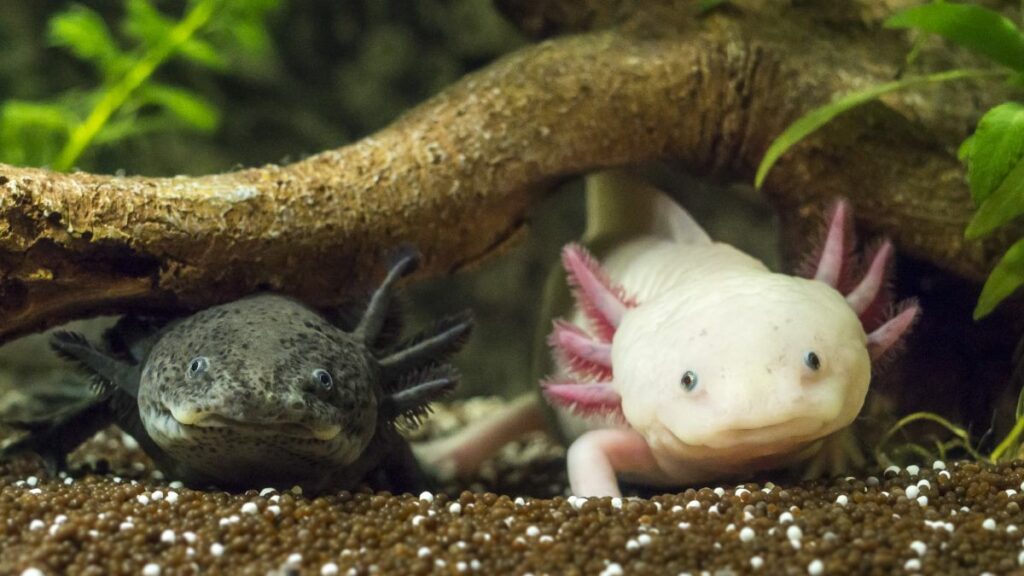
Fish might also pick at their feathery external gills or sensitive skin, which will cause infections. Skin infections in amphibians are very hard to treat and often fatal.
Since amphibians breathe through their skin they tend to absorb medications in huge doses. It makes treating disease difficult to do. So it’s better to avoid causing them any kind of injury.
Can You Have More Than One Axolotl in a Tank?
Keeping more than one axolotl in the same tank is risky business. Young axolotls are not social, nor are adult axolotls.
And when they do meet you may end up in trouble. If there is a major size difference, the larger baby axolotl may just eat the smaller one.
Like other amphibians captive axolotls can regenerate missing limbs or other body parts that are lost. But the wounds may still get infected, causing disease.
And sometimes the new limb isn’t as functional as the original. Unless you plan on breeding axolotls it is best to keep them solo.
If you still want to try keeping axolotls together then provide 20 gallons of space per axolotl larvae. And feed them often so they are less likely to try eating each other.
How to Breed Axolotls
You will need a spacious breeding tank for a pair. 40 gallons of space is best if they are full-grown and always living together. Otherwise, a 20-gallon tank is enough for them to get to know one another, mate, and then be separated.
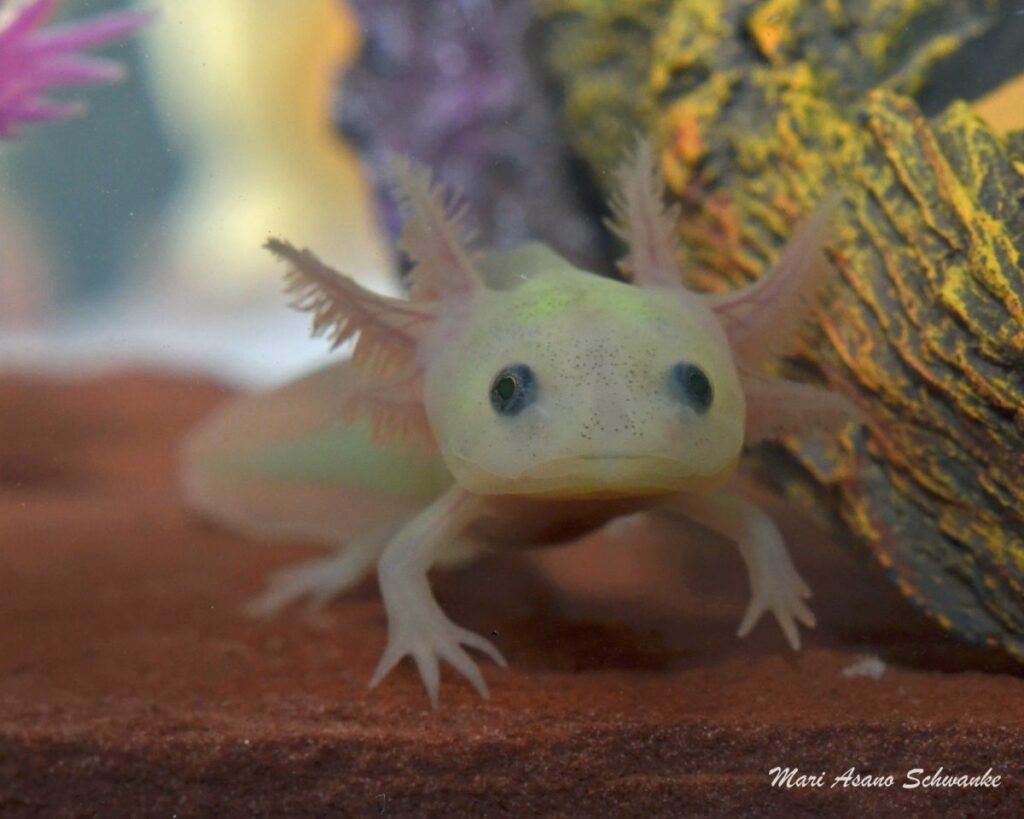
Sexing axolotls is challenging if you’ve never done it before. Females will look plumper from above. A male axolotl is slimmer and has a longer tail. You should also examine the cloaca; a male axolotl has a visible lump there while female axolotls do not.
Once they mate female axolotls will lay a mass of slime-covered eggs. These eggs hatch in two to three weeks, depending on the water temperature. Newborn axolotl larvae are tadpole like when they hatch and feed on brine shrimp.
Conclusion
Baby axolotls are one of the easier amphibians to care for. They eat worms, fish, and other foods with gusto. Water conditions are unimportant so long as you keep the temperature low.
And they are comfortable with few decorations, though dim lighting is recommended.
More Frequently Asked Questions about Baby Axolotl Care
Axolotl babys are long lived pest that need little to get by and are always interesting to watch. But I often get frequent questions on other aspects of the care of this critically endangered species. Here are some of the most common ones you might be interested in.
Little is needed other than a powerful filter, dim lighting, and cool to cold water temperature. I also recommend a sand substrate since baby axolotls sometimes swallow gravel by accident. Swallowed gravel may get stuck in their intestines, causing blockages that require veterinary advice.
Morphed axolotl larvae will breed though caring for them is more complicated. Once morphed an axolotl is a land dwelling animal. So you will need a morphed male and female if you want to breed them. If they are genetically predisposed to morph then that gene will be passed on in axolotl eggs.
Wild axolotls are found in central Mexico. The lakes surrounding Mexico City are their natural habitat. But they are critically endangered in the wild due to pollution and habitat loss. Therefore it is important to breed axolotls in captivity so one day they will be returned to their native habitat.

